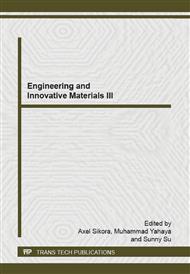[1]
S. Berber, Y. Kwon and D. Tománek, Unusually high thermal conductivity of carbon nanotubes, Phys. Rev. Lett. 84 (2000) 4613-4616.
DOI: 10.1103/physrevlett.84.4613
Google Scholar
[2]
P. Kim, L. Shi, A. Majumda and P.L. McEuen, Thermal transport measurements of individual multiwalled nanotubes, Phys. Rev. Lett. 87 (2001) 215502.
DOI: 10.1103/physrevlett.87.215502
Google Scholar
[3]
M. Fujii, X. Zhang, H. Xie et al., Measuring the thermal conductivity of a single carbon nanotube, Phys. Rev. Lett. 95 (2005) 065502.
Google Scholar
[4]
C. Guthy, F. Du, S. Brand et al., Thermal conductivity of single-walled carbon nanotube/PMMA nanocomposites, Trans. ASME 129 (2007) 1096-1099.
DOI: 10.1115/1.2737484
Google Scholar
[5]
L. E. Nielsen, The thermal and electrical conductivity of two-phase systems, Ind. Eng. Chem. Fundam. 13 (1974) 17-20.
Google Scholar
[6]
R. Haggenmuller, C. Guthy, J. R. Lukes et al., Single wall carbon nanotube/polyethylene nanocomposites: thermal and electrical conductivity, Macromol. 40 (2007) 2417-2421.
DOI: 10.1021/ma0615046
Google Scholar
[7]
F. H. Gojny, M. H. G. Wichmann, B. Fiedler et al., Evaluation and identification of electrical and thermal conduction mechanisms in carbon nanotube/epoxy composites, Polym. 47 (2006) 2036-(2045).
DOI: 10.1016/j.polymer.2006.01.029
Google Scholar
[8]
K. Yang, M. Gu, Y. Guo, X. Pan, G. Mu, Effects of carbon nanotube functionalization on the mechanical and thermal properties of epoxy composites, Carbon 47 (2009) 1723-1737.
DOI: 10.1016/j.carbon.2009.02.029
Google Scholar
[9]
X. Xu, M.M. Thwe, C. Shearwood and K. Liao, Mechanical properties and interfacial characteristics of carbon-nanotube-reinforced epoxy thin films, Appl. Phys. Lett. 81 (2002) 2833-2835.
DOI: 10.1063/1.1511532
Google Scholar
[10]
F. El-Tantawy, K. Kamada and H. Ohnabe, In situ network structure, electrical and thermal properties of conductive epoxy resin-carbon black composites for electrical heater applications, Matter. Lett. 56 (2002) 112-126.
DOI: 10.1016/s0167-577x(02)00401-9
Google Scholar
[11]
Z. Han and A. Fina, Thermal conductivity of carbon nanotubes and their polymer nanocomposites: A review, Prog. Polym. Sci. 36 (2011) 914-944.
DOI: 10.1016/j.progpolymsci.2010.11.004
Google Scholar
[12]
P. Dashora and G. Gupta, On the temperature dependence of the thermal conductivity of linear amorphous polymers, Polym. 37 (1996) 231-234.
DOI: 10.1016/0032-3861(96)81092-5
Google Scholar
[13]
N. Jović, D. Dudić, A. Montone et al., Temperature dependence of the electrical conductivity of epoxy/expanded graphite nanosheets composites, Scripta Materialia 58 (2008) 846-849.
DOI: 10.1016/j.scriptamat.2007.12.041
Google Scholar


